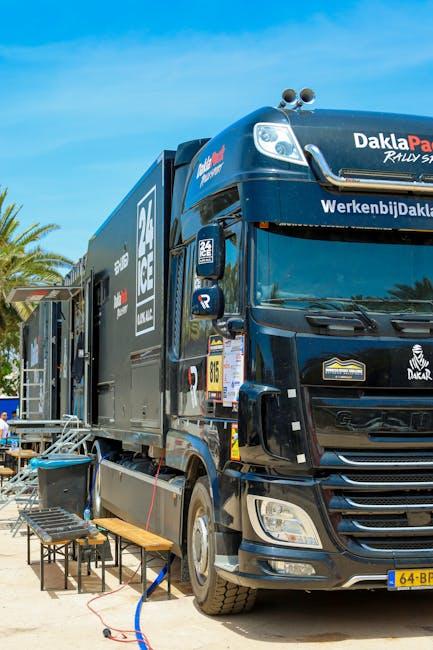A smooth ride and solid control can transform every journey behind the wheel, turning ordinary drives into extraordinary experiences. At the heart of this transformation lies your car’s suspension system — the unsung hero that absorbs shocks, maintains stability, and keeps your tires firmly planted on the road. Upgrading your car suspension isn’t just a matter of improving performance; it’s an investment in comfort, safety, and handling precision. Whether you’re a casual driver looking to enhance everyday comfort or an automotive enthusiast chasing spirited cornering, understanding how to upgrade your suspension system opens the door to a tailor-made driving experience. In this article, we’ll explore the essentials of car suspension upgrades, guiding you through the choices that can elevate your ride to new heights.
Table of Contents
- Understanding the Fundamentals of Car Suspension Systems
- Choosing the Right Suspension Upgrade for Your Driving Style
- Essential Tools and Safety Measures for Suspension Replacement
- Step-by-Step Guide to Removing and Installing Suspension Components
- Fine-Tuning Suspension Settings for Optimal Performance
- Common Challenges and Expert Tips for a Smooth Suspension Upgrade
- Q&A
- Key Takeaways

Understanding the Fundamentals of Car Suspension Systems
The car suspension system is the unseen hero that balances comfort and control, absorbing shocks from uneven terrain while keeping your tires firmly planted on the road. At its core, it consists of several key components: springs, shock absorbers, struts, and control arms. Springs cushion the vehicle against jolts, while shock absorbers and struts dampen the oscillations to prevent bouncing. Control arms connect the suspension to the frame, allowing for smooth vertical wheel movement and maintaining alignment. Understanding how these parts work together forms the foundation for making smart upgrades that enhance both ride quality and handling.
When considering enhancements, it’s crucial to know your suspension’s geometry and how various upgrades affect it. For instance, installing stiffer springs typically improves cornering but may reduce comfort, while upgrading to performance shocks can provide better response without compromising ride quality drastically. Here’s a quick breakdown of common suspension components and their primary function:
| Component | Purpose | Upgrade Benefit |
|---|---|---|
| Springs | Absorb vertical motion | Improved stability and ride height control |
| Shock Absorbers | Dampen spring oscillations | Enhanced ride comfort and handling |
| Struts | Combine shock and structural support | Better chassis rigidity and handling precision |
| Control Arms | Connect suspension to frame | Maintain proper wheel alignment |
Having a clear grasp of these fundamentals allows car enthusiasts to pick upgrades tailored to their driving style—whether it’s smooth street cruising or aggressive track days. Always consider how changes to one component influence the overall system to maintain a harmonious balance between performance and comfort.

Choosing the Right Suspension Upgrade for Your Driving Style
When upgrading your car’s suspension, it’s essential to align your choice with how and where you typically drive. For daily city commuting, prioritizing comfort and smoothness will pay off—look for suspension kits designed to absorb potholes and reduce road vibrations. In contrast, if you enjoy spirited weekend drives or track days, a performance-oriented setup with stiffer springs and adjustable dampers might better suit your needs, providing sharper handling and more responsive feedback.
Consider the following factors to narrow down your upgrade options:
- Driving environment: Urban, highway, off-road, or track.
- Ride comfort: Soft for comfort, firm for control.
- Vehicle type and weight: Sedans, SUVs, or sports cars may require different specs.
- Budget: High performance parts often come at a premium.
| Driving Style | Recommended Suspension Type | Benefit |
|---|---|---|
| Daily Commuting | Comfort-oriented Springs & Shocks | Reduced road noise & vibrations |
| Sport/Track Use | Coilovers with Adjustable Dampers | Improved cornering & control |
| Off-Road | Heavy-Duty Lift Kits | Better ground clearance & durability |

Essential Tools and Safety Measures for Suspension Replacement
Before diving into the hands-on work of upgrading your car’s suspension, assembling the right toolkit is crucial. Having high-quality, reliable instruments not only eases the process but significantly reduces the risk of errors or damage. Key tools include a sturdy jack and jack stands to securely lift and hold your vehicle, a set of wrenches and sockets tailored to your car’s specifications, and a spring compressor to handle the often dangerous task of removing and installing coil springs. Additionally, investing in a torque wrench ensures that all bolts and nuts are tightened to manufacturer-recommended specifications, preserving the integrity of the suspension components.
Safety should always be your north star during suspension replacement. This means working in a well-lit, spacious area free from distractions and hazards. Always wear protective gloves and safety glasses to safeguard against sharp edges and flying debris. Before starting, double-check that the vehicle is stable and supported correctly using jack stands rather than relying solely on a hydraulic jack. It is wise to keep a fire extinguisher nearby when working with tools and chemicals. Below is a simple checklist to keep your workspace safe and efficient:
- Secure vehicle stability: Use jack stands on level ground
- Wear personal protective equipment: Gloves and safety glasses
- Organize tools within reach: Avoid unnecessary movements during work
- Inspect suspension parts: Replace any rusted or worn components immediately
- Keep lighting bright and shadows minimal: Ensure clear visibility

Step-by-Step Guide to Removing and Installing Suspension Components
Begin by safely lifting your car using a reliable jack and securing it with jack stands to ensure stability. Before removing any parts, gather all necessary tools—wrenches, sockets, spring compressors, and penetrating oil are essential. Start with loosening the lug nuts and removing the wheels to access the suspension. Carefully detach components like the shocks, struts, or control arms by loosening their mounting bolts. Use penetrating oil if the bolts are stubborn, and note the orientation of each part to ease reinstallation. Handle springs with care and use a spring compressor to avoid injury when dealing with coil-over setups.
Once components are removed, inspect each part and clean mounting points before installing the new suspension elements. Position the new parts according to OEM specifications, and snugly fasten all bolts in a cross pattern to distribute pressure evenly. For final torque values, refer to the table below, which highlights typical tightening specifications for common suspension components:
| Component | Tightening Torque (Nm) |
|---|---|
| Control Arm Bolts | 110-140 |
| Strut Mount Nuts | 45-60 |
| Shock Absorber Bolts | 60-80 |
| Sway Bar End Links | 25-35 |
After assembly, double-check all connections and lower the vehicle cautiously. It’s advisable to perform an alignment to ensure optimal handling and tire wear. These meticulous steps guarantee a smooth transition to your upgraded suspension system, enhancing both performance and safety on the road.

Fine-Tuning Suspension Settings for Optimal Performance
Dialing in your suspension is where the magic happens—it’s what transforms raw upgrades into a finely tuned driving experience. Start by adjusting the spring preload to control ride height and initial firmness, allowing the car to handle different loads without compromising balance. Next, focus on damping settings: softer settings improve comfort, while firmer adjustments reduce body roll during aggressive cornering. Finding the right mix depends largely on your driving style and road conditions, so take time to experiment.
Use this quick guide to pinpoint key adjustment areas:
- Compression Damping: Controls how quickly suspension compresses after hitting a bump.
- Rebound Damping: Regulates how fast the suspension extends back after compression.
- Ride Height: Impacts aerodynamics and center of gravity.
| Setting | Effect | Recommended Use |
|---|---|---|
| Soft Compression | Better cushioning over rough surfaces | Daily driving |
| Firm Compression | Reduces excessive body movement | Track or spirited drives |
| Moderate Rebound | Balanced extension speed | Versatile street and weekend use |

Common Challenges and Expert Tips for a Smooth Suspension Upgrade
Upgrading your car’s suspension can be a rewarding project, but it’s not without its hurdles. One common challenge is ensuring compatibility between new components and your vehicle’s existing system. A mismatch can lead to poor handling or even damage. To avoid this, always verify specifications and seek parts tested for your model. Another frequent issue is improper installation, which could compromise safety and performance. Taking the time to follow detailed guides or consulting with professionals ensures the upgrade goes smoothly.
Expertise plays a huge role in navigating these challenges. Here are some tips to keep in mind:
- Perform a thorough inspection of existing suspension parts before beginning to identify wear or damage.
- Use quality tools to prevent stripping bolts or causing misalignments.
- Balance comfort and performance by selecting the right combination of springs and dampers tailored to your driving style.
- Double-check torque specifications during assembly to ensure components are securely fastened.
- Test drive cautiously after the upgrade to notice any irregularities early.
| Challenge | Expert Tip |
|---|---|
| Component incompatibility | Cross-reference model-specific specs |
| Incorrect installation | Follow trusted step-by-step guides |
| Poor ride quality | Choose suitable springs and dampers |
| Loose fittings | Adhere to torque settings |
Q&A
Q: Why should I consider upgrading my car suspension?
A: Upgrading your car suspension enhances ride comfort, handling, and overall driving experience. It can improve stability during cornering, reduce body roll, and allow for better control on rough or uneven roads.
Q: What are the main types of suspension upgrades available?
A: Popular upgrades include installing performance shock absorbers or struts, swapping springs for lowering or lifting, adding sway bars, or opting for coilover kits that combine springs and shocks for adjustable handling.
Q: Can I upgrade my suspension myself, or should I hire a professional?
A: While some upgrades like replacing shocks or springs can be DIY-friendly for those with mechanical skills and proper tools, complex installations, especially coilovers or custom setups, are best handled by professionals to ensure safety and optimal performance.
Q: How do I choose the right suspension components for my car?
A: Consider your driving style (comfort vs. performance), vehicle type, budget, and the typical roads you drive on. Research manufacturer specs and read reviews, then match parts like springs, shocks, or coilovers to your specific goals.
Q: Will upgrading suspension affect my car’s warranty or insurance?
A: It can. Some manufacturers void warranties if aftermarket suspension parts are installed. Insurance policies might also be impacted if modifications alter vehicle performance. Always check with your dealer and insurer before making changes.
Q: How long does a suspension upgrade usually take?
A: Depending on the complexity, a basic shock and spring swap can take a few hours, while installing coilovers or custom components might require a full day or more at a shop.
Q: What signs indicate it’s time to upgrade my suspension?
A: If you notice excessive bouncing, poor handling, uneven tire wear, or your car bottoms out frequently, it might be time to consider an upgrade. Also, if you want improved driving dynamics or to accommodate larger wheels, suspension mods can help.
Q: Are there any drawbacks to upgrading car suspension?
A: Potential downsides include increased stiffness leading to a harsher ride, higher maintenance costs, or reduced ground clearance with lowering springs. It’s important to balance improvements with practical needs.
Q: What maintenance is required after upgrading suspension?
A: Regularly check for wear on shocks and springs, ensure bolts remain tight, and get wheel alignments after installation to maintain proper handling and tire longevity.
Q: Can suspension upgrades improve fuel efficiency?
A: Indirectly, yes. Better handling and stability can lead to smoother driving and reduced drag, but aggressive lowering or heavier components might actually decrease fuel economy. The effect is usually minor compared to other modifications.
Key Takeaways
Upgrading your car’s suspension is more than just a mechanical tweak—it’s an investment in comfort, control, and confidence every time you hit the road. Whether you’re chasing smoother rides, sharper handling, or a personalized driving experience, understanding the nuances of suspension upgrades empowers you to make informed choices. As you embark on this journey, remember that patience and precise adjustments go hand in hand with performance gains. So, roll up your sleeves, embrace the process, and watch your car transform from ordinary to extraordinary—one suspension upgrade at a time.

